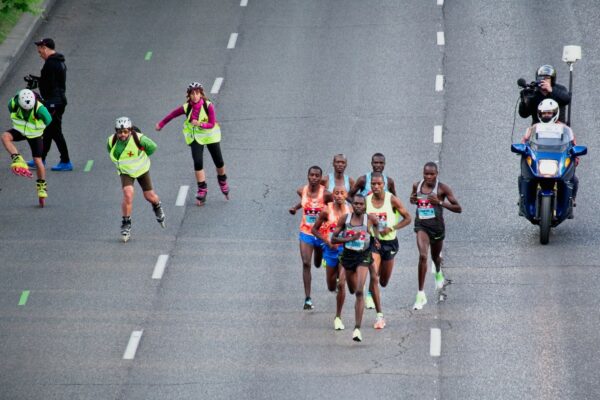The marathon race is for the vast majority of runners the ultimate distance. We could call it the ‘king distance’ for all runners. Marathon Guide To Run Your Best Long Distance Race is a marathon guide for you who want to take up the challenge. It does not mean it is easy in practice but the training methods are relatively simple.
Marathon Races
Over the years, many have tested their capacity with the marathon distance and every year new ones sign up for the challenge. The marathon training is not always easy to follow but easy to understand.

your prerequisites for starting a marathon training project may be that you have participated in several public races at shorter distances up to, for example, a half-marathon and you have been running for two or more years and know your body well.
Our physiology reacts differently and it is not always easy to predict when unexpected things will pop up and we will not be able to control the weather, the competitors, the hills or if we forget to consume food and fluid in one of the depots on the route.
After approx. 30 kilometers, even experienced elite runners will feel the consequences of their pace, and more of them will have to slow down the pace due to leg cramps because the lactic acid limit is exceeded or they become bothered by stomach cramps and vomiting due to decreased sugar tolerance.
However, the most common cause of failing performance is the encounter with the ‘wall’, as a result of the shift to fat-burning, which often happens very suddenly without advance notice.
Marathon Training

Training forward for a marathon race in the future is not just about running. There are many other factors that also must be taken into consideration such as our daily routines, family, work, etc.
And You do not get through a marathon without drinking fluids along the way as pure water or a sugar solution, which you have to train too.
You must also train the ability to burn fat so that you can save on the glycogen stores and thereby maintain a higher speed. Thus, the body must be able to store more glycogen as efficiently as possible.
The long runs help to empty the glycogen stores, which means that a larger amount of glycogen is stored afterward. So, over time you can store significantly more glycogen than before you started the marathon training.
Marathon Training Program
The marathon concepts below build further on the basic training. Marathon training programs can be divided into three groups or steps:
The long run

A sensible marathon training program consists of 2 long runs a week. They both aim to continue the endurance training from the basic training.
It will be a good idea to find a hilly route both because of variety but also because a hilly route places greater demands on the muscles in the legs and thus provides a greater training effect.
Remember the long runs must be run at a pleasant pace, the talking pace – you can use the Borg scale for this purpose. This so-called basic pace will over time become faster and faster, as long as you are patient and let your body adapt to the training.
Lactic acid threshold

In the coming weeks, the lactic acid threshold training will move the limit where the lactic acid begins to accumulate in the muscles, so you will be able to run closer to the limit for the maximum oxygen uptake.
The lactic acid limit corresponds approximately to your half-marathon pace. The lactic acid limit can be found by running for one hour on a measured flat route with maximum effort.
Based on the distance you have completed; you can calculate the time you spend per kilometer. This pace can then be used as the pace at which the lactic acid training should take place.
If you use a sports watch, the average heart rate of one hour of running can also be used as an indicative training load.
The lactic acid training starts as intervals with long breaks between the work intervals. Later, lactic acid training includes speed training, test runs and preparation for competitions.
The length of the pace runs should be between 20 and 40 minutes of work. Due to the duration, the intensity will automatically be close to the lactic acid limit.
The test runs must be run by maximum and is a good indicator of whether you are in the right shape in relation to the goal or whether it is time to change your ambitions.
Competition participation at this build-up level helps to sharpen the competition mentality and at the same time gets you used to run in a field where you can be pushed a bit by the other runners.
The competition races as part of the marathon training are shorter than the marathon race itself. The pace should be just below maximum effort.
Oxygen uptake
Training of maximum oxygen uptake is a very hard form of training that is performed using interval training, which should be run with an intensity that is very close to the actual maximum oxygen uptake.
This corresponds approximately to the pace you can complete at a 3 km distance with maximum effort.
It is important that the breaks between the work periods are adapted to the length of the work period. The optimal rest period should last between 50 and 90% of the length of the work period.
That means a work period of 4 minutes is replaced by a rest period of between 2 minutes and 3.30 minutes. During the rest period, you should jog or walk around but not stand still, as the blood circulation in the legs will thus drop drastically.
Marathonguide – Preparation for the Marathon

A marathon race can often be a game of chance, as there are so many things that must go up in a higher unit for the race itself to be a success.
But with the right preparations, you can do a lot to make the race a positive experience. You can use training programs from Marathon Training Buddy or find one that fits you on the internet.
The most important thing you can do before the race is to build up as large glycogen stores as possible, make sure to drink plenty and at the same time ensure that the training in the last weeks up to the race is not too hard.
During the race itself, you should remember to keep an eye on your kilometer times. But today you can choose to follow the experienced pace keepers – the balloon holders – with mileage times painted on the balloons to ‘run to the time’.
If the weather is hot and humid, it is often necessary to adjust the expectations. Heat and marathon running is a bad cocktail due to the large fluid loss that the heat causes. The pace in marathon races in warm environments is usually lower than in the typical spring and autumn races.

Marathon Taper Schedule
Although the path to marathon success goes beyond constant, concentrated and well-structured training, there will come a time in the training process where more and harder training not will have a positive effect on the expected performance ability.
Many people overlook the benefits of a ‘tapering period’ which means a reduction in training for a few weeks up to the marathon race itself. However, studies have shown that you are able to keep your shape through 4 to 6 weeks even when the amount of training is reduced by 50 %.
A tapering period of the training is important to be able to ‘save’ some energy for the planned race. So, you so to speak have fresh and good legs, which are fully recovered on race day. The amount of training is gradually reduced already 3 weeks before the race itself.
In this way, you maintain fast legs but you avoid that they are too tired from the major amount of training. The goal is to be fresh and ready at the start time.
This also means that the glycogen stores must be full and the amount of fluid in the body must be as large as possible and this is ensured by cutting back on the training so that the body has time to build up these depots.
Final Thoughts
It can be difficult to adapt a training program that, on the one hand, has a sufficient amount of training and hardness and at the same time allows for sufficient recovery. It will depend on individual circumstances. So you have to try to customize your own program.
I hope you like this blog and if you have any questions about the topic or want to leave your own Personal review, please leave a comment below.
[faq-schema id=”4008″]






I have to be honest, I had no clue so much went into preparing for a marathon. What you just shared has helped me understand so much! I honestly want to thank you for opening my eyes. Whether lactic acid or oxygen uptake training, I’ve learned a ton about how to prepare for a marathon.
Quick question, in your opinion, approximately how long does it take someone to gain enough confidence to start participating in marathons?
Hi Rod Singleton
Thank you for the comment. Happy that you learned something from it. When it comes to confidence to start… it’s very individual but I would start using the SMART MODEL from ex. here: https://bit.ly/3cvAzBN
Be Well
Thanks for this Henrik, I decided running in the evenings sometime after I started working from home due to Covid-19. I had so much time on my hands after work that I thought it would be good exercise. How wrong I was. Those first few weeks were excruciating! Given that I was not doing any fitness activity, muscle soreness was at an all time high. But somehow I never gave up.
I struggled with a burning sensation in my throat and chest, later learnt that this is lactic acid build up (and a higher demand on breathing), which you’ve coincidentally highlighted in point two. This is quite informative. My usual route is around 5k and I’ve noticed when I give myself two days off to recovery I run much better.
Hi Steve
Thank you for the comment. Happy that you could learn something from it. You never gave up and it seems that you have found the recovery time that works for you.
Be Well
I’ve always been amazed by people who run marathon, but I never though it could be such a lot of work and to get to know your body well, after reading your article, I learned more about what is a marathon and what anyone who is interested on doing it needs to know to get well prepared. I’m sure your marathon guide will help many to know more about the steps to get well prepare to have a great time running their first marathon!
Hi Alejandra
Thank you for the comment. – Preparation and Starting with small steps is always the best method in my opinion.
Be Well